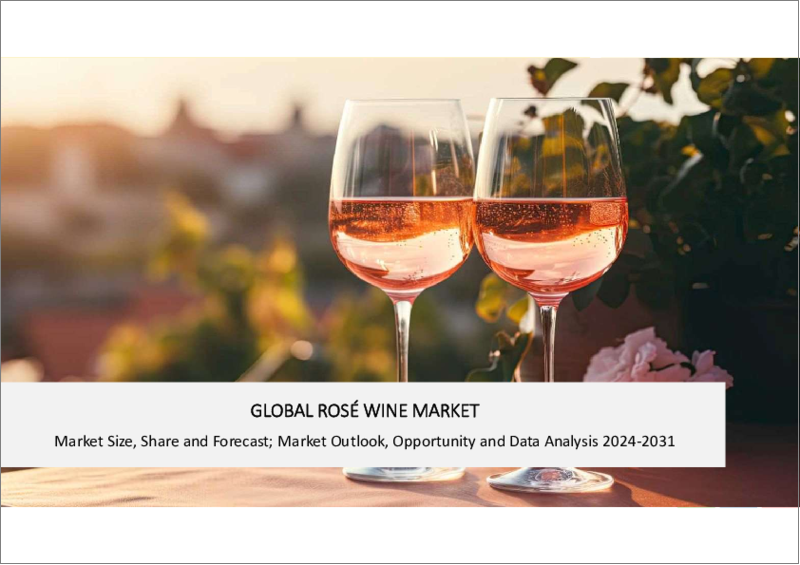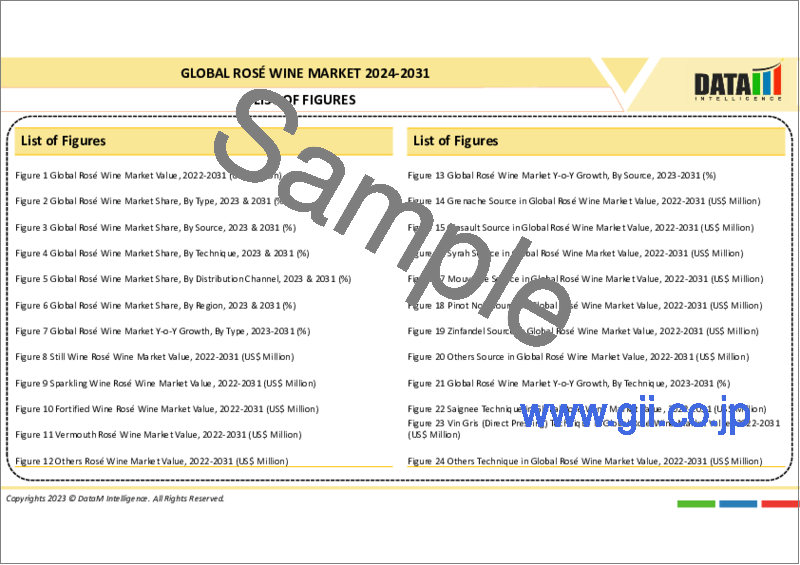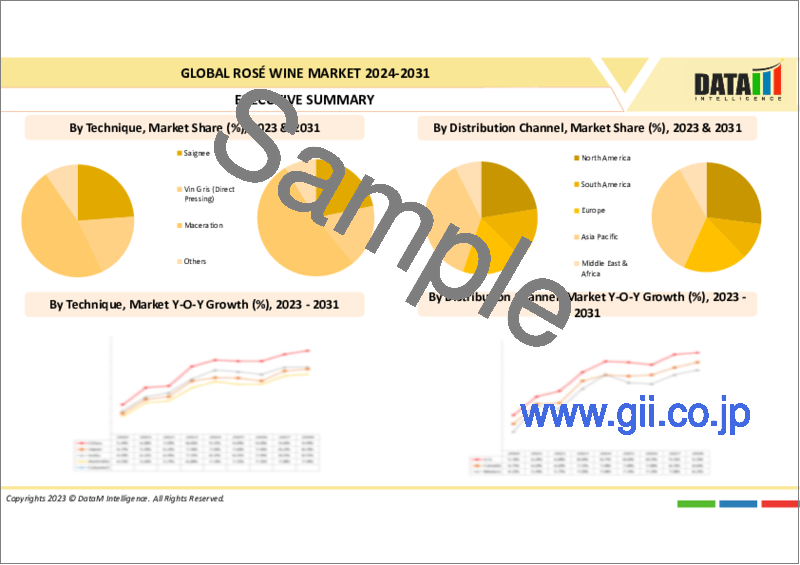|
|
市場調査レポート
商品コード
1304575
ロゼワインの世界市場-2023年~2030年Global Rose Wine Market - 2023-2030 |
||||||
カスタマイズ可能
適宜更新あり
|
|||||||
| ロゼワインの世界市場-2023年~2030年 |
|
出版日: 2023年07月07日
発行: DataM Intelligence
ページ情報: 英文 190 Pages
納期: 即日から翌営業日
|
- 全表示
- 概要
- 目次
市場概要
世界のロゼワイン市場は、2022年に31億米ドルに達し、2030年には46億米ドルに達すると予測され、予測期間2023-2030年のCAGRは5.3%で成長すると予測されています。
ロゼワインは、従来の性別や年齢の固定観念を超え、多くの消費者の間で人気を博しています。一日中ロゼを楽しむ」というトレンドが生まれ、消費者はロゼを様々な場面で楽しめる万能なワインとして受け入れています。特にミレニアル世代や若い層のワイン消費動向の高まりは、ロゼワイン市場の成長にプラスの影響を与えています。
ロゼワイン市場は現在、多様なスタイル、風味、ブドウ品種を提供しています。従来は軽めで果実味を前面に押し出したものが多かったが、現在では爽やかな辛口から甘口でフルボディのものまで、バラ・ワインのバリエーションが広がっています。ワイン生産者は、多様な消費者の嗜好に応えるため、様々なブドウ品種やワイン醸造技術を試し、ユニークで個性的なロゼワインを生み出しています。
市場力学
若年層のアルコール摂取量の増加がロゼワイン市場の成長を牽引
若年層、特にミレニアル世代とジェネレーションZは、より軽くて汎用性の高いアルコール飲料を好みます。例えば、Ground Reportによると、平均1億6,000万人がアルコールを消費しており、そのうち95%は18歳から49歳の男性です。この嗜好は、爽やかで果実味豊かなことで知られるロゼワインの特徴と一致しています。若年層が様々なアルコールの選択肢を模索する中で、ロゼワインの親しみやすさと生き生きとした風味に惹かれ、市場成長の原動力となっています。
若年層は、アルコールが消費される社交活動や集まりに参加することが多いです。トレンディでインスタ映えするロゼワインは、この層の間で人気の選択肢となっています。屋外イベント、屋上でのパーティー、カジュアルな集まりなどとの関連性は、若年層のライフスタイルや嗜好に合致しており、消費の増加と市場成長に寄与しています。
可処分所得の増加が市場成長を牽引
可処分所得が増加するにつれ、消費者はワインの購入を含む裁量支出に振り向けられる財源が増えます。サンフランシスコを拠点とするカリフォルニアワイン業界の業界団体であるワイン・インスティテュートによると、アメリカのワイン消費量は2021年の10億ガロンから11億ガロンに増加しました。ロゼワインは、他のいくつかのプレミアム・ワイン・カテゴリーと比較して、手頃な価格で入手しやすいことが多く、可処分所得が増加している消費者にとって魅力的な選択肢となっています。
可処分所得の増加に伴い、消費者はロゼワインを含むより高品質な製品の購入に積極的になることが多いです。消費者はより洗練されたプレミアム・ワインの選択肢を求めるようになり、特定のブドウ品種から作られたプレミアム・ロゼワインや、有名なワイン産地で生産されたプレミアム・ロゼワインに追加出費することを厭わなくなっています。このようなプレミアム化の動向は、ロゼワインの市場成長を促進します。
他のワインスタイルとの競合がロゼワイン市場を抑制する可能性
赤ワインと白ワインは、何世紀にもわたって消費されてきた伝統的なワインスタイルです。赤ワインや白ワインを強く好む消費者は、ロゼワインにあまり興味を示さないかもしれないです。より馴染みのあるワインスタイルが好まれるため、ロゼワインの市場ポテンシャルが制限され、異なるワインカテゴリー間で競合が生じる可能性があります。
消費者の中には、ロゼワインを赤ワインや白ワインよりも格下、あるいは低品質な選択肢として認識する人もいます。このような認識は、歴史的な観念や個人的な偏見に基づいている可能性があります。その結果、消費者は品質が優れていると認識する他のスタイルのワインを選ぶようになり、ロゼワイン市場の成長が制限される可能性があります。
COVID-19影響分析
COVID-19分析には、COVID前シナリオ、COVIDシナリオ、COVID後シナリオに加え、価格力学(COVID前シナリオと比較したパンデミック中およびパンデミック後の価格変動を含む)、需給スペクトラム(取引制限、封鎖、およびその後の問題による需給の変化)、政府の取り組み(政府機関による市場、セクター、産業を活性化させる取り組み)、メーカーの戦略的取り組み(COVID問題を緩和するためにメーカーが行ったことをここで取り上げる)が含まれます。
ロシア・ウクライナ戦争の影響
戦争は、ロゼワインを含む商品の輸出入の遅延や制限につながっています。貿易の混乱は、影響を受けた市場でのロゼワインの入手に影響を与え、価格変動につながる可能性があっています。紛争はこの地域に経済的不安定をもたらし、消費者の購買力や市場の需要に影響を与えました。不確実性や不安定性は、消費マインドや裁量支出の低下を招き、ロゼワイン市場に悪影響を及ぼす可能性があります。消費者はこのような不確実な時期には、ワインのような贅沢品よりも必需品を優先する可能性があります。
AIの影響
人工知能(AI)は、醸造、直接圧搾やブレンドなどの醸造方法、発酵、熟成など、ロゼワイン市場の様々な側面に影響を与える可能性があります。AIは、醸造過程における品質管理を支援することができます。機械学習アルゴリズムは、ブドウ園の状況、天候パターン、ブドウの特徴など、様々な情報源から収集したデータを分析し、ロゼワイン生産の品質と一貫性を最適化することができます。
AIは発酵プロセスの最適化を支援することができます。温度、pHレベル、糖度などのデータをリアルタイムで監視・分析することで、AIを搭載したシステムはワインメーカーが発酵条件をより正確にコントロールし、風味の向上と一貫性の維持につなげることができます。AIはロゼワインの熟成・熟成プロセスを支援することができます。過去のデータと官能プロファイルを分析することで、AIアルゴリズムは温度や湿度レベルなどの最適な熟成条件を提案し、望ましい風味プロファイルを実現し、長期にわたって安定した品質を確保することができます。
目次
第1章 調査手法と調査範囲
第2章 市場の定義と概要
第3章 エグゼクティブサマリー
第4章 市場力学
- 市場への影響要因
- 促進要因
- 抑制要因
- 機会
- 影響分析
第5章 産業分析
- ポーターのファイブフォース分析
- サプライチェーン分析
- 価格分析
- 規制分析
第6章 COVID-19分析
第7章 製品タイプ別
- スティルワイン
- スパークリングワイン
- 酒精強化ワイン&ベルモット
第8章 流通チャネル別
- スーパーマーケット/ハイパーマーケット
- 専門店
- オンライン販売
- その他
第9章 地域別
- 北米
- 米国
- カナダ
- メキシコ
- 欧州
- ドイツ
- 英国
- フランス
- イタリア
- スペイン
- その他欧州
- 南米
- ブラジル
- アルゼンチン
- その他南米
- アジア太平洋
- 中国
- インド
- 日本
- オーストラリア
- その他アジア太平洋地域
- 中東・アフリカ
第10章 競合情勢
- 競合シナリオ
- 市況/シェア分析
- M&A分析
第11章 企業プロファイル
- Domaine de Cala
- 会社概要
- 製品ポートフォリオと説明
- 財務概要
- 主な発展
- Chateaux de Lastours
- Campuget
- Blossom Hill
- Tesco
- Echo Falls
- Bna Wine Group
- Chapoutier
- Maison Louis Jadot
- Penny Johnson Flowers
第12章 付録
Market Overview
The Global Rose Wine Market reached US$ 3.1 billion in 2022 and is expected to reach US$ 4.6 billion by 2030 and is expected to grow with a CAGR of 5.3% during the forecast period 2023-2030.
Rose wine has gained popularity among many consumers, transcending traditional gender and age stereotypes. The trend of "rose all day" has emerged, with consumers embracing rose as a versatile and enjoyable wine choice for various occasions. The rising trend of wine consumption, particularly among millennials and younger demographics, has positively influenced the growth of the rose wine market.
The rose wine market now offers diverse styles, flavors, and grape varieties. While traditionally associated with lighter and fruit-forward profiles, a greater variety of rose wines are now available, ranging from crisp and dry to sweeter and fuller-bodied styles. Wine producers are experimenting with different grape varieties and winemaking techniques to create unique and distinct rose offerings, catering to diverse consumer preferences.
Market Dynamics
Increase in Intake of Alcohol Among Young Adults is Driving the Market Growth of the Rose Wine Market
Young adults, particularly millennials and Generation Z prefer lighter and more versatile alcoholic beverages. For instance, according to Ground Report, on average, 160 million people consume alcohol; out of them, 95% are male aged between 18 and 49 years. This preference aligns with the characteristics of rose wine, which is known for its refreshing and fruit-forward nature. As young adults explore different alcoholic options, they are drawn to the approachability and vibrant flavors of rose wine, driving its market growth.
Young adults often engage in social activities and gatherings where alcohol is consumed. Rose wine, with its trendy and Instagram-worthy appeal, has become a popular choice among this demographic. Its association with outdoor events, rooftop parties, and casual get-togethers aligns with the lifestyle and preferences of young adults, contributing to increased consumption and market growth.
Growing Disposable Income can Drive the Market Growth
As disposable income increases, consumers have more financial resources to allocate toward discretionary spending, including wine purchases. According to the Wine Institute, a San Francisco-based trade association for the California wine industry, American wine consumption increased from 1 billion gallons in 2021 to 1.1 billion gallons in 2021. Rose wine, in comparison to some other premium wine categories, is often more affordable and accessible, making it an attractive choice for consumers with increasing disposable income.
With rising disposable income, consumers often exhibit a willingness to trade up and purchase higher-quality products, including rose wine. As consumers seek more sophisticated and premium wine options, they are willing to spend extra on premium rose wines made from specific grape varietals or produced in renowned wine regions. This trend towards premiumization drives the market growth of rose wine, as consumers are willing to pay higher prices for higher-quality offerings.
Competition From Other Wine Styles can Restrain the Rose Wine Market
Red and white wines are well-established and traditional wine styles that have been consumed for centuries. Consumers who strongly prefer red or white wines may be less inclined to explore rose wines. This preference for more familiar wine styles can limit the market potential for rose wines and create competition among different wine categories.
Some consumers may perceive rose wine as a less prestigious or lower-quality option than red or white wine. This perception could be based on historical notions or personal biases. As a result, consumers may opt for other wine styles they perceive as superior in quality, limiting the growth of the rose wine market.
COVID-19 Impact Analysis
The COVID-19 Analysis includes Pre-COVID Scenario, COVID Scenario, and Post-COVID Scenario along with Pricing Dynamics (Including pricing change during and post-pandemic comparing it with pre-COVID scenarios), Demand-Supply Spectrum (Shift in demand and supply owing to trading restrictions, lockdown, and subsequent issues), Government Initiatives (Initiatives to revive market, sector or Industry by Government Bodies) and Manufacturers Strategic Initiatives (What manufacturers did to mitigate the COVID issues will be covered here).
Russia-Ukraine War Impact
The war led to delays or restrictions in the import and export of goods, including rose wine. Trade disruptions impacted the availability of rose wine in the affected markets and potentially lead to price fluctuations. The conflict created economic instability in the region, affecting consumer purchasing power and market demand. Uncertainty and instability can lead to a decline in consumer confidence and discretionary spending, which can have a negative impact on the rose wine market. Consumers may prioritize essential goods over luxury items like wine during such uncertain times.
AI Impact
Artificial intelligence (AI) has the potential to impact various aspects of the rose wine market, including vinification, vinification methods such as direct pressing and blending, fermentation, and aging. AI can assist in quality control during the vinification process. Machine learning algorithms can analyze data collected from various sources, such as vineyard conditions, weather patterns, and grape characteristics, to optimize the quality and consistency of rose wine production.
AI can assist in optimizing fermentation processes. By monitoring and analyzing real-time data such as temperature, pH levels, and sugar content, AI-powered systems can help winemakers control fermentation conditions more precisely, leading to improved flavor development and consistency. AI can aid in the aging and maturation process of rose wines. By analyzing historical data and sensory profiles, AI algorithms can provide recommendations on optimal aging conditions, such as temperature and humidity levels, to achieve desired flavor profiles and ensure consistent quality over time.
Segment Analysis
The Global Rose Wine Market is segmented based on product type, distribution channel, and region.
The Versatility & Refreshing Taste of Sparkling Wine has Contributed to Segment Growth.
By product type, the rose wine is classified into still wine, sparkling wine, fortified wine & vermouth.
In 2022, sparkling wine held the highest share in the rose wine market. Sparkling wine, including sparkling rose, is often associated with celebrations, special occasions, and festive gatherings. Its effervescence and elegant appearance make it a popular choice for toasting and creating a sense of luxury and indulgence. For instance, according to Forbes, the world now produces 2.5 billion bottles of sparkling wines.
The pink hue of sparkling rose wine adds an element of visual appeal, making it visually enticing to consumers. The attractive color distinguishes it from other sparkling wine options and adds to the overall sensory experience. Sparkling rose wine is versatile when it comes to food pairing. Its acidity and effervescence make it a suitable companion for many cuisines and dishes, including seafood, salads, light meats, and desserts. This versatility has contributed to its growing popularity among wine enthusiasts.
Geographical Analysis
North America is the Fastest Growing Market in the Rose Wine Market
There has been a notable increase in consumer demand for rose wine in North America. For instance, according to IWSR Drinks Market Analysis, Sparkling rose wine volume in the U.S. climbed by 118 percent in 2020. This can be attributed to changing consumer preferences, shifting away from traditional wine choices, and embracing the light, refreshing, and versatile characteristics of rose. The trend of "rose all day" has gained popularity, with consumers incorporating rose wine into various occasions and social gatherings.
There has been a cultural shift in North America, with a growing appreciation for wine and a desire for more diverse and experiential drinking options. Millennials and younger consumers, in particular, have shown a strong affinity for rose wine, perceiving it as trendy. The rise of wine culture and the influence of social media have further fueled the popularity of rose wine.
Competitive Landscape
The major global players in the market include Domaine de Cala, Chateaux de Lastours, Campuget, Blossom Hill, Tesco, Echo Falls, Bna Wine Group, Chapoutier, Maison Louis Jadot, and Penny Johnson Flowers
Why Purchase the Report?
- To visualize the Global Rose Wine Market segmentation based on product type, distribution channel, and region and understand key commercial assets and players.
- Identify commercial opportunities in the market by analyzing trends and co-development.
- Excel data sheet with numerous data points of the rose wine market-level with all segments.
- The PDF report consists of a comprehensive market analysis after exhaustive qualitative interviews and an in-depth market study.
- Product mapping is available as Excel consists of key products of all the major market players.
The Global Rose Wine Market Report Would Provide Approximately 53 Tables, 48 Figures, And 190 Pages.
Target Audience 2023
- Manufacturers/ Buyers
- Industry Investors/Investment Bankers
- Research Professionals
- Emerging Companies
Table of Contents
1. Methodology and Scope
- 1.1. Research Methodology
- 1.2. Research Objective and Scope of the Report
2. Market Definition and Overview
3. Executive Summary
- 3.1. Market Snippet, by Type
- 3.2. Market Snippet, by Packaging
- 3.3. Market Snippet, by Distribution Channel
- 3.4. Market Snippet, by Region
4. Market Dynamics
- 4.1. Market Impacting Factors
- 4.1.1. Drivers
- 4.1.2. Restraints
- 4.1.3. Opportunity
- 4.1.4. Impact Analysis
5. Industry Analysis
- 5.1. Porter's Five Force Analysis
- 5.2. Supply Chain Analysis
- 5.3. Pricing Analysis
- 5.4. Regulatory Analysis
6. COVID-19 Analysis
- 6.1. Analysis of COVID-19 on the Market
- 6.1.1. Scenario Before COVID
- 6.1.2. Scenario During COVID
- 6.1.3. Scenario Post COVID
- 6.2. Pricing Dynamics Amid COVID-19
- 6.3. Demand-Supply Spectrum
- 6.4. Government Initiatives Related to the Market During Pandemic
- 6.5. Manufacturers Strategic Initiatives
- 6.6. Conclusion
7. By Product Type
- 7.1. Introduction
- 7.1.1. Market Size Analysis and Y-o-Y Growth Analysis (%), By Product Type
- 7.1.2. Market Attractiveness Index, By Product Type
- 7.2. Still Wine*
- 7.2.1. Introduction
- 7.2.2. Market Size Analysis and Y-o-Y Growth Analysis (%)
- 7.3. Sparkling Wine
- 7.4. Fortified Wine & Vermouth
8. By Distribution Channel
- 8.1. Introduction
- 8.1.1. Market Size Analysis and Y-o-Y Growth Analysis (%), By Distribution Channel
- 8.1.2. Market Attractiveness Index, By Distribution Channel
- 8.2. Supermarket/Hypermarket*
- 8.2.1. Introduction
- 8.2.2. Market Size Analysis and Y-o-Y Growth Analysis (%)
- 8.3. Specialty Stores
- 8.4. Online Sales
- 8.5. Others
9. By Region
- 9.1. Introduction
- 9.1.1. Market Size Analysis and Y-o-Y Growth Analysis (%), By Region
- 9.1.2. Market Attractiveness Index, By Region
- 9.2. North America*
- 9.2.1. Introduction
- 9.2.2. Key Region-Specific Dynamics
- 9.2.3. Market Size Analysis and Y-o-Y Growth Analysis (%), By Product Type
- 9.2.4. Market Size Analysis and Y-o-Y Growth Analysis (%), By Distribution Channel
- 9.2.5. Market Size Analysis and Y-o-Y Growth Analysis (%), By Country
- 9.2.5.1. The U.S.
- 9.2.5.2. Canada
- 9.2.5.3. Mexico
- 9.3. Europe
- 9.3.1. Introduction
- 9.3.2. Key Region-Specific Dynamics
- 9.3.3. Market Size Analysis and Y-o-Y Growth Analysis (%), By Product Type
- 9.3.4. Market Size Analysis and Y-o-Y Growth Analysis (%), By Distribution Channel
- 9.3.5. Market Size Analysis and Y-o-Y Growth Analysis (%), By Country
- 9.3.5.1. Germany
- 9.3.5.2. The U.K.
- 9.3.5.3. France
- 9.3.5.4. Italy
- 9.3.5.5. Spain
- 9.3.5.6. Rest of Europe
- 9.4. South America
- 9.4.1. Introduction
- 9.4.2. Key Region-Specific Dynamics
- 9.4.3. Market Size Analysis and Y-o-Y Growth Analysis (%), By Product Type
- 9.4.4. Market Size Analysis and Y-o-Y Growth Analysis (%), By Distribution Channel
- 9.4.5. Market Size Analysis and Y-o-Y Growth Analysis (%), By Country
- 9.4.5.1. Brazil
- 9.4.5.2. Argentina
- 9.4.5.3. Rest of South America
- 9.5. Asia-Pacific
- 9.5.1. Introduction
- 9.5.2. Key Region-Specific Dynamics
- 9.5.3. Market Size Analysis and Y-o-Y Growth Analysis (%), By Product Type
- 9.5.4. Market Size Analysis and Y-o-Y Growth Analysis (%), By Distribution Channel
- 9.5.5. Market Size Analysis and Y-o-Y Growth Analysis (%), By Country
- 9.5.5.1. China
- 9.5.5.2. India
- 9.5.5.3. Japan
- 9.5.5.4. Australia
- 9.5.5.5. Rest of Asia-Pacific
- 9.6. Middle East and Africa
- 9.6.1. Introduction
- 9.6.2. Key Region-Specific Dynamics
- 9.6.3. Market Size Analysis and Y-o-Y Growth Analysis (%), By Product Type
- 9.6.4. Market Size Analysis and Y-o-Y Growth Analysis (%), By Distribution Channel
10. Competitive Landscape
- 10.1. Competitive Scenario
- 10.2. Market Positioning/Share Analysis
- 10.3. Mergers and Acquisitions Analysis
11. Company Profiles
- 11.1. Domaine de Cala*
- 11.1.1. Company Overview
- 11.1.2. Product Portfolio and Description
- 11.1.3. Financial Overview
- 11.1.4. Key Developments
- 11.2. Chateaux de Lastours
- 11.3. Campuget
- 11.4. Blossom Hill
- 11.5. Tesco
- 11.6. Echo Falls
- 11.7. Bna Wine Group
- 11.8. Chapoutier
- 11.9. Maison Louis Jadot
- 11.10. Penny Johnson Flowers
LIST NOT EXHAUSTIVE
12. Appendix
- 12.1. About Us and Services
- 12.2. Contact Us





